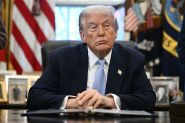- Home
- Middle East
- National Guard in LA: A Clash of Power and Politics

National Guard troops stand outside a downtown Los Angeles jail on Sunday after two days of clashes sparked by immigration raids and ongoing protests. ©SPENCER PLATT / GETTY IMAGES NORTH AMERICA / Getty Images via AFP
As tensions in Los Angeles spiked during the weekend following anti Immigration and Customs Enforcement (ICE) protests, the California National Guard found itself at the center of a heated clash over authority, law and optics. This time, under a federal deployment that bypasses state approval.
What Is the National Guard?
The National Guard functions under a dual-status model. Under state control (Title 32), governors deploy the National Guard in local crises, like fires, floods or protests. When federalized (mobilized by the president under Title 10), Guard units become part of the US Army and report to the Department of Defense. Guard members are typically part-time soldiers and civilians, blending roles as community responders with the capacity for overseas combat missions.
Why the Deployment Now?
Tensions mounted after ICE conducted sweeping raids across neighborhoods, including Compton, Boyle Heights and Paramount, leading to highway protests and clashes in downtown LA. The LAPD reported being overwhelmed during violent demonstrations, including freeway blockades, thrown projectiles and fires.
In response, President Trump ordered up to 2,000 National Guard troops under Title 10, with 300 already deployed and 500 Marines on standby, despite no formal request from Governor Gavin Newsom.
A Historical Pattern and a Turning Point
This isn't Trump’s first use of the Guard. In 2020, he urged governors to send troops to Washington, DC, amid George Floyd affair protests; some complied, others declined, citing state sovereignty.
What sets today apart is that this marks the first federalization of a state Guard over a governor’s objection since 1965, when President Lyndon B. Johnson dispatched troops to Alabama during the Selma civil rights marches.
Local Leaders Push Back
Governor Newsom denounced the move as unconstitutional overreach. On X, he accused Trump of “manufacturing a crisis” to justify militarizing Los Angeles and bypassing democratic norms. He emphasized that local law enforcement had the situation under control and called on the federal government to stand down.
Mayor Karen Bass echoed that frustration, calling the deployment “provocation, not a solution” and urging negotiations rather than displays of force.
Trump addressed Newsom and Bass on X, saying that if they “can’t do their jobs, which everyone knows they can’t, then the Federal Government will step in and solve the problem, the way it should be solved.”
Legal Experts Warn of Limits
Georgetown law professor Steve Vladeck, a specialist in military justice, emphasized that without invoking the Insurrection Act, Guard troops cannot perform routine law enforcement tasks. He also highlighted that, as per the President’s memorandum, their sole authorized role is “to ensure the protection and safety of Federal personnel and property.” Therefore, they cannot arrest or detain civilians just for protesting.
“There’s nothing these troops will be allowed to do that, for example, the ICE officers against whom these protests have been directed could not do themselves. And because of the Posse Comitatus Act, the reverse is not true; there is plenty that these troops cannot legally do that the ICE officers can,” he added.
Vladeck also warned that this blurred role “will only raise the risk of escalating violence, not decrease it.”
What the Guard Can and Can’t Do
Currently, Guard units are stationed around federal buildings, transit hubs and ICE facilities. Their duties are restricted to defensive and logistical support. They are not authorized to make arrests, patrol neighborhoods or intervene in protests unless the Insurrection Act is explicitly invoked.
For now, Los Angeles remains a potent symbol of this tension, where military mobilization, civil dissent and political disagreements converge. The question is evolving beyond who holds the streets to who controls the power to deploy them.
Read more





Comments